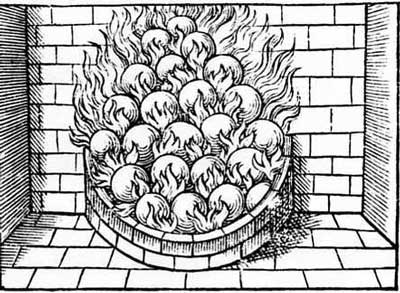

Sir Hugh Plat. A new, cheape and delicate Fire of Cole-balles, wherein Seacole is by the mixture of other combustible bodies, both sweetened and multiplied. London, 1603.
“In the winter season after some few frosts, gather so much lome as will serve your house for one whole yeares spending (for then it will crumble and dissolve more easily in water then at other times)...
...half a peck, & happily a lesse proportion of this lome, dissolved in a little tub of water, is a sufficient quantitie for the knitting up of a bushel of seacole into balles, and your water and lome incorporated and well laboured together must be like a very thin pap.
Then take a bushel of the best seacole, which being strewed upon a stonie or paved floore, you must breake or bruise with a hammer, mallet, or… powder them under your feete.
[Mix until] the whole masse or lumpe of your coles soft enough to be wrought up into balles, between your hands, according to the maner and making of snowballs: then place them one by one, so as they touch not ech other til they be thorough drie, which will be in a few dayes.”
Plat felt that the coal dust and loam balls caused less 'smoot' and should be piled like cannon balls for an attractive fire. The effects of the smoke upon the city were discussed by John Evelyn in his pamphlet, "Fumifugiumor, The Inconveniencie of the Aer and Smoak of London Dissipated" 1772(1661)
This very early recipe for a fuel similar to charcoal briquettes can be viewed in the small booklet in the facsimile copy from Amsterdam: Theatrum Orbis Terrarum; NY: Da Capo Press, 1972
Charcoal Making in the 19th Cen. by Conner Prairie
Past Recipes of the Month
